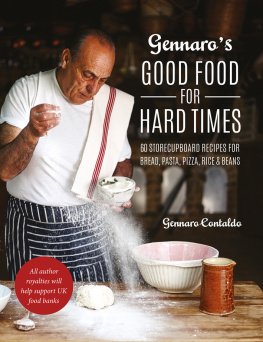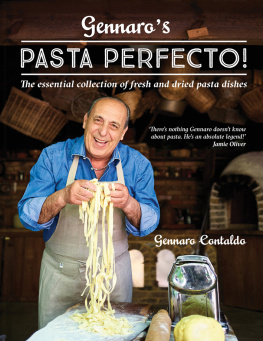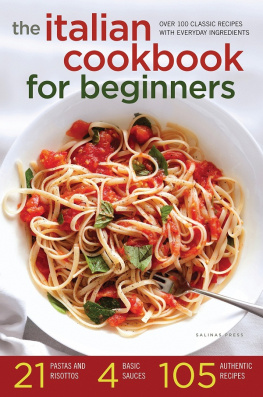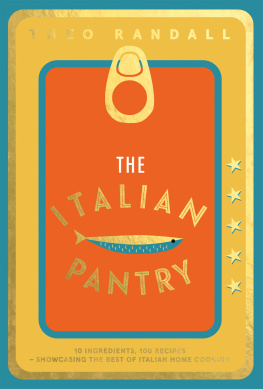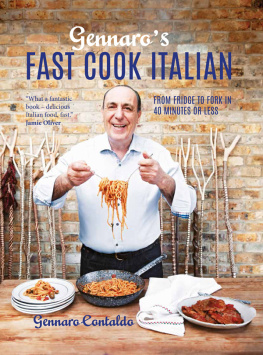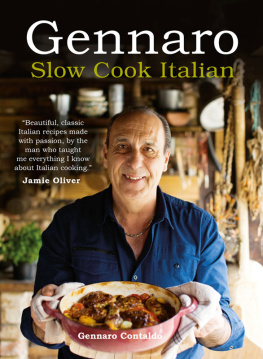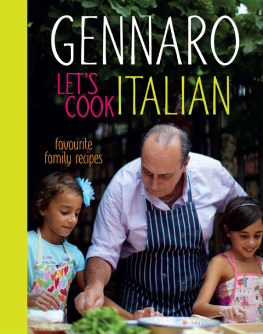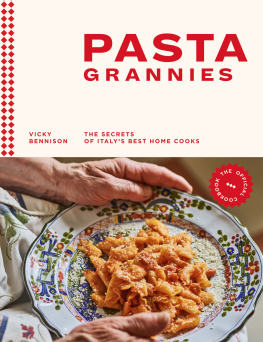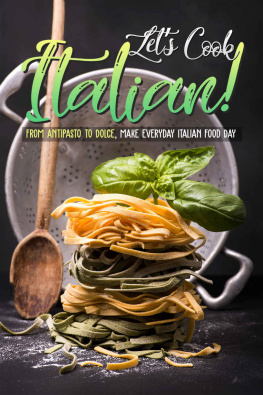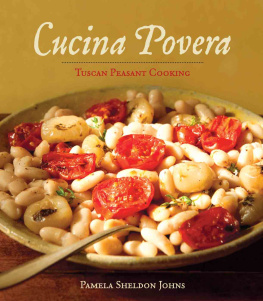Contents
Guide



GENNAROS GOOD FOOD FOR HARD TIMES
What strange and challenging times we are living in at the moment. Weve been told to stay at home, not go into work, not meet friends, not travel anywhere of course this is all for a good reason and the more we stay at home, the sooner these restrictions will be over.
This obviously means we are spending a lot of time at home and the one thing we all have to do is EAT. Your local Italian will be closed, but with all the extra time not spent commuting, this is a perfect opportunity to cook meals from scratch. I have therefore put together a collection of some of my favourite storecupboard recipes for bread, pasta, pizza, rice and beans, which are simple, delicious and wont break the bank!
Cooking from scratch is not only healthier but you can make it fun and get the family involved. Perhaps youve never made your own bread or fresh pasta its a great skill to acquire and nothing beats that magical moment when the bread dough rises and the freshly made loaves are taken out of the oven still amazes me, even after years of cooking and baking. Kids will love to make their own pizza and fun pasta shapes. With just a few basic ingredients, flour, yeast and water the possibilities are endless.
Dont forget to raid your storecupboard for those tins and packets of beans and pulses. Combined with a couple of fresh ingredients, you can make simple, delicious, hearty meals in no time.
These are the foods and dishes of my childhood, a time when food was never wasted and good nutritious meals were always cooked from scratch. I hope you enjoy recreating these recipes, not only during this challenging time, but also for many years to come.
Stay safe, happy cooking and buon appetito!
Gennaro xx


PANE
BREAD
For me, there is no other foodstuff more satisfying and complete than bread. It has been a staple in most countries of the world for thousands of years. There was a time when people had bread to eat and little else; it is one of the most basic foods of human life.
Italians take bread very seriously it is present at every meal from dunking into milky coffee at breakfast to accompanying all courses during lunch and dinner. And the traditional merenda (teatime snack) for children after school has always been pane, burro e marmelata (bread, butter and jam). If, for any reason, fresh bread is not available, Italians always keep a storecupboard supply of grissini, taralli, freselle or other hard-baked bread substitutes, just in case.
Bread also forms a vital part of the Italian food culture and is intertwined in many local traditions, rituals, feasts and religious festivities. Traditionally, festive breads were made on the day the village celebrated its patron saint; volunteers would go from door to door with big baskets filled with votive breads in exchange for an offering. Bread and religion are closely linked and bread is said to be a gift from God. This is probably why leftover bread is never wasted and it is considered bad luck to throw it away, so any leftovers are made into breadcrumbs or used up in other culinary ways. There are even whole museums dedicated to this humble but important foodstuff throughout Italy in Trapani Sicily, Cosenza and in Sardinia.
It is said Italy produces over 1500 types of bread. Every region, town, village and even bakery has its own specialities, whether its the way the bread is cooked, left to rise, the type of flour or the shape of the loaf, the varieties are endless and fascinating. Probably the most famous is the Pane di Altamura bread from the little town in Puglia which a few years ago made international news when locals fought to close down McDonalds in favour of a bakery. The rustic loaf is made with local hard durum wheat semola flour, is a lovely yellow colour with a hard crust, and has been made a Denomacin de Origen (DOP) protected product. There is also the Pane di Genzano, a town outside Rome, whose soft white loaf covered in wheat bran has also been given DOP status.
There is nothing more pleasurable than making your own bread and the aroma from the oven from a freshly baked loaf is one of the best. It is so simple to make a standard traditional loaf flour, yeast, salt and water which forms the basis of most breads including the popular grissini (breadsticks), which are so often found on the Italian table at mealtimes for anyone preferring a light and crunchy alternative.
For the next step up, enriched breads, like Casatiello, which is made in southern Italy at Easter, are made perhaps for a special occasion and packed with lots of other ingredients. Italians are also now experimenting with age-old grains like spelt, buckwheat, and adding seeds to their dough for a healthier approach.
Traditionally, bread is made with a biga (starter), which is still used in Italian bakeries. A small amount of dough from the previous days baking is kept and added to start a new dough. The biga, or la Madre (mother) as it is sometimes referred to, starts with flour and water and is left to ferment naturally for a long time, or sometimes organic plain yogurt can be added or a tiny amount of yeast to speed up the process.

THE STAGES OF BREAD MAKING
MIXING
This is when you combine the basic ingredients usually flour and salt then pour in the yeast mixture and remaining liquid. Mix with either a wooden spoon or, as I prefer, by hand, until all the ingredients are well incorporated and form into a dough. All the recipes in this book have been tried and tested; however, you may find you need to add a little more or less liquid sometimes weather humidity plays an important factor. If you find you have added all the liquid and it is too much, simply add a little flour.
KNEADING
This is the process of manipulating the dough so the yeast is evenly distributed and the proteins in the flour develop the gluten. Lightly flour a work surface and place the dough on it. Place the heel of your hand on top of the dough and push away from you. Using your fingertips, flip the dough over, pulling the dough back towards you. Continue doing this, alternating hands, for about 10 minutes or as specified in the recipe. To see if a dough has been kneaded for long enough, roll it tightly into a ball, poke it with your finger if it springs back readily and has a smooth appearance, it is ready. Some enriched doughs, such as brioche, can be very sticky, so these are easier made in a mixing bowl or in a freestanding mixer with the dough hook attachment.
RISING
This is the stage when the dough is set to rest so that it can expand. Place the ball of dough into a large bowl, cover with either a cloth or clingfilm, and leave in a warm place. This can be near a source of heat, the linen cupboard, warm utility room or in the oven with just the light on. On a hot day, it can be left anywhere in the kitchen. Follow rising times as stated in the recipes; however, you may find that you need a little shorter or longer. Basically an hour should suffice for normal bread dough, but the general rule is until the dough has doubled in size. Be careful the dough could also over-rise and collapse. If this happens, knead the dough for a few minutes and leave to rise again. You can make dough in advance, cover it with clingfilm and store it in the refrigerator, where it will rise very slowly, and then use it when required.

